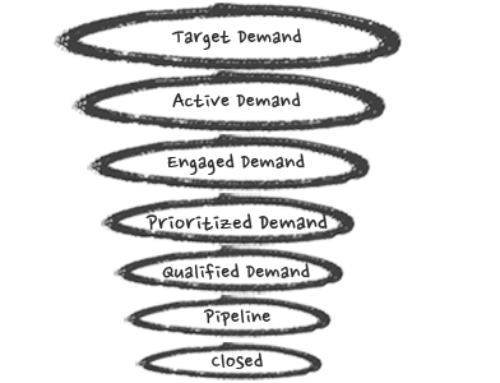
The principal objective in the Qualified Demand stage is to get direct interaction with the account so we can understand their needs and determine what their budget, timeline, and authority to purchase are. This is generally done through a series of meetings or phone conversations between the sales team and the account, though it may be occasionally possible to validate by email.
The stumbling blocks
Identifying individuals within target accounts to call on. You will need to target the entire Demand Unit. That means that the sales team’s outreach needs to be to multiple contacts within the target account. If you know the typical makeup of the job titles in the Demand Unit for your products, you may be able to acquire contact lists to provide the sales team. In other cases, you will not have a typical Demand Unit across accounts.
When you don’t have a standard Demand Unit, there is going to be no substitute for old-fashioned account-by-account research. A sales development team that can do the research necessary to identify those individuals in each account will be critical to success.
There are well-established tools on the market that your sales development team can use to identify the right contacts such as Hoover’s, LinkedIn Sales Navigator, ZoomInfo, and such that make the process most efficient. Many of these tools connect directly to sales engagement and sales automation (CRM) platforms directly so the salespeople can access contacts from within their existing tools.
If you don’t have a sales development team, there are companies such as LeadGenius that can provide this is a service. Ideally, you will have several contacts identified through forms completed on your site, but even in the absence of this, there’s a rich enough set of tools on the market that the sales team can research and find the right contacts. Their bandwidth will be the deciding factor of whether or not to outsource this work.
Email and call cadences
Creating and optimizing email and call cadences. In most companies, the marketing team is responsible for creating outbound emails along with call scripts for the sales organization. Those communications can range from generic to specific. Your objective is to ensure that the message maps to the needs of the accounts and is customized to the interests of the different members of the Demand Unit; essentially, persona-based communications.
Cadence compliance. Unless your programs are enterprise-level 1:1 sales and marketing, you are going to want to work with your sales managers to track, monitor, and manage cadence compliance. Without compliance, you will find it impossible to understand what is working and what is not.
Ensuring consistency and compliance can be a point of friction between sales and marketing, but it needn’t be. Use it as an opportunity to invite input and feedback from the sales teams, but get them to agree to a system where field and floor input is encouraged and then evaluated as a group. Put the system of testing and evaluation of the suggestions into a process with sales management because the most effective way to drive improvement is a joint venture between sales and marketing.
You achieve several desirable outcomes with this approach: you have the opportunity to get great input from the sales field and floor which is often perceptive, you build a strong sense of teamwork between sales and marketing, and as your tests start to improve results, those results accrue to the entire sales organization.
Cadence construction. Figuring out how many emails and phone calls will be in each cadence, along with the timing of each cadence step makes a huge difference in results. Do you want four emails and five calls? Do you want the cadence to run over a period of one week, two weeks, 30 days? Do you want it to be five calls and three emails? Should the calls and emails happen on the same days or different days?Here again, you will need to test and optimize; however, you can lean on industry best practices as your baseline. The best data I have yet to come across on cadences comes from SalesLoft, a sales engagement platform. In the most extensive study I have seen, they looked at 200 million sales interactions from their platform and ran statistical models to determine what the ideal cadence looks like. I encourage you to take a look at their blog post here. It’s a little nerdy, but incredibly helpful and more importantly provides specific guidance on best practices. If you genuinely want to get into the weeds, on that blog post is this link to the scientific paper upon which it is based. It has a lot of valuable information mixed in with their methodologies, math, and statistical equations (which is where it gets really nerdy!). Even if you are not a statistician, you will get the gist of it.

In the above example, the outbound email and calling cadence is spread over 14 days with different activities scheduled at specified intervals. Often the generation of the emails and call scripts is the responsibility of the marketing team, though the sales managers are going to want to (and should) provide a lot of input.
Preparing for success
Demand Unit personas. Your job will be much easier if you have a clear view of the different personas in the Demand Unit. Even if your product management team has not done extensive interviews to uncover the makeup of a typical Demand Unit, you should still prepare personas based on what you do know as a starting baseline for creating content and ensuring alignment with sales.
Outbound emails. All emails should come from a system that is integrated into your CRM. I know that in some companies there is resistance to that from the sales team, but being able to track and view every interaction with every contact at every account is critical for long-term success.
Outbound cold calling. Here too, the calls should be made from a system that is integrated into your CRM, and for the same reasons. An added benefit of using a sales engagement platform is that calls can be configured to be recorded. I have spent a lot of time listening to these recordings and have found it to be a valuable tool to not only hear what prospects say but also to understand what additional materials need to be produced for sales training.
Social media engagement. Many salespeople have found success in interacting with prospects through social media. This can take various forms, perhaps the most common being LinkedIn in-mails, though there is some risk at this point of it being overused. Once again it’s vital that all of these interactions be captured in your CRM.
Sales engagement platforms. You should automate the outbound call and email cadences through sales engagement platforms like SalesLoft. These systems allow you to write the emails and call scripts and then put them into programmed cadences.
An additional advantage with sales engagement platforms is that the salespeople can automate parts of the process and know which accounts need to be touched each day. For marketers, they also offer the ability to run split tests on the cadences and for sales management, a dashboard to track all the activities.
While the emails and scripts are programmed into the system, salespeople retain the ability to modify them on a contact-by-contact basis as necessary.
Account-based advertising and retargeting. This is no time to stop your advertising efforts. You want to keep the awareness levels up and continue to influence the account. Ideally, you will have specific ads and promotions tied to this Qualified Demand stage in the Waterfall, but even if you do not, you can continue running ads that were used higher in the Waterfall so that you keep awareness up and stay front-of-mind.
Sales enablement materials. In addition to sales training, objection handling, and systems training, you will need to produce collateral that will be integrated into the email cadences. Whether it is a link to content or resources for downloading, you will want to have some of these things produced to drive interaction with the prospect.
Team makeup
Being effective in this Qualified Demand stage requires an extensive amount of teamwork between the marketing, marketing operations, sales operations, and sales teams.
The marketing team will need input and support as it builds out it’s messaging for the cadences, especially the call scripts as the sales team will generally have the best feel for the discussion points and talk track. If the marketing team does not integrate those into the scripts, they won’t get used.
You are going to need to work with sales management on developing a robust sales enablement program that trains on the systems, cadences, and dispositioning rules. Without all of that, you are likely to find that each salesperson is doing something completely different.
Integrating cadences into your sales automation tool requires the involvement of the sales and marketing operations teams. Fortunately, most sales engagement platforms are designed to plug directly into the leading CRMs, so there typically isn’t heavy lifting involved.
It’s worth reiterating that sales and marketing managers must work tightly together on cadence compliance or adoption and usage will be spotty at best. You will also be challenged to measure or optimize results.
Deliverables
- Cadences for each of the personas in your Demand Unit. You may also need to customize them to industry, geography or other firmographic.
- Call scripts (for leaving voicemails) and email copy
- Collateral that will be attached/linked from emails
- Ads, landing pages to be integrated into your account-based advertising and/or remarketing programs
Measuring success for Qualified Demand
The principal KPI for Qualified Demand is the number of accounts that have been validated to have a budget, timeline, need and authority in order to enter the sales pipeline (or whatever variation of this is established with sales management to classify an account as an “opportunity”).
Other things you will want to measure which will impact this KPI are related to the activities surrounding the cadences. You will want to track:
- Cadence completions
- Cadence compliance
- Number of contacts per account (based on your demand unit definition)
- Meetings set
- Email & call response rates
You will also want to pay close attention to the content of the emails and call scripts to be able to identify open and response rates.
Make sure to set aside time to listen to call recordings or live calls. You are busy. I get it. But there is no substitute for listening in on customer interactions. It actually saves you a lot of time in the long run by giving you actionable information that you can use to fine-tune messaging and sales enablement.



